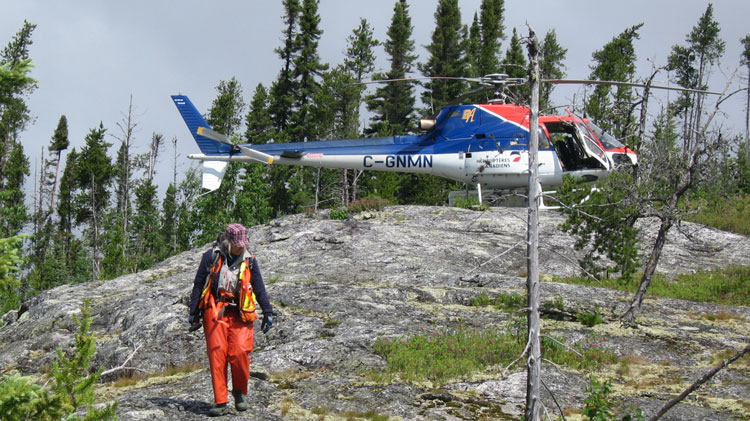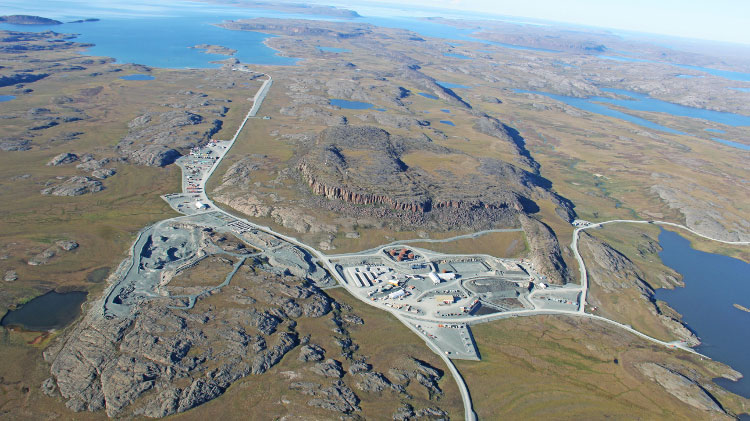Cold temperatures are a boon for northern construction projects like Gahcho Kué that rely on ice roads as transportation corridors. Courtesy of Mountain Province Diamonds
When asked about the challenges of building a diamond mine in the Northwest Territories, Mountain Province Diamonds CEO Patrick Evans says drily, “It’s bloody cold.” But a seasonably cold winter augurs sunny days ahead for both his company and De Beers. The two companies entered into a joint venture in 2002 and are on track to commission their Gahcho Kué diamond mine in 2016, thanks to the Tibbit to Contwoyto winter road opening on schedule this year.
More than half-way through a two-year construction phase, about 2,100 truckloads of equipment and materials were delivered to the mine site during February and March via the annual ice road in the highest-volume trucking season the mine will ever experience.
Shipments in recent months, says Evans, included “the diamond plant, the mining fleet, fuel, explosives and a great deal more.” Having everything on site by the end of March, he adds, should enable the completion of construction by the end of the year and the start of plant commissioning at the beginning of 2016.
At the intersection of money and good weather
Accessibility is the biggest challenge when building a mine in the Canadian North. Because the site is 280 kilometres northeast of Yellowknife, the 22 million litres of diesel fuel that Gahcho Kué will require over the next 14 months had to be trucked in during the eight-week ice road season. Neither the fleet of 240-ton Komatsu haul trucks and dozers nor the four Finning generators can be flown into the mine’s 4,500-foot airstrip, either. Gahcho Kué will account for more than a quarter of the estimated 10,500 truckloads travelling over the ice road this year, delivering supplies to mines in the N.W.T. and western Nunavut.
Around 280 contractors – a number that will rise to 700 during peak construction activity later this year – have carried on construction of the mine despite an unexpected complication. Deutsche Bank, the head of a lending group that was to participate in a debt facility for the joint venture, was unable to secure credit approval for the mine for reasons, Evans stresses, that were unrelated to the project. Scotiabank was able to stand in at the eleventh hour, and the companies officially announced credit approval for a US$370 million financing deal in early February.
“Project finance is very, very complicated in the best of circumstances,” says Evans. “To have to change a horse in mid-stride is very difficult, but under the circumstances it was a reasonably smooth transition.”
The line of credit is the final piece of the puzzle in funding the $858-million construction phase. The development of the mine will continue to be financed by equity until the end of March, at which point Mountain Province will begin drawing on the debt facility for capital and working capital to push through to commercial production. De Beers is funding its share of the costs internally.
Diamonds are special
The site will eventually process three million tonnes of kimberlite per year over a 12-year mine life, producing an estimated 4.5 million carats annually. For De Beers, which owns 51 per cent of the unincorporated joint venture, the project could represent a powerful brake on over two decades of a declining market share. The project is the largest and richest new diamond mine in the world, and the seventh largest overall in terms of expected value produced.
While finding a new diamond mine is said to be a hundred times harder than finding a new gold mine, freeing the gems should prove somewhat simpler. Evans, who has experience in the platinum, copper, nickel and gold sectors, says processing the ore at Gahcho Kué will be easier than any project he has worked on before. A mill and crushers, supplied by IMS Engineering, will break down the ore and feed it into a Polysius high-pressure grinding roller. Then dense media separation separates a diamond concentrate from the ore, before X-rays and grease belts remove the diamonds from the concentrate. The diamonds will be split between the partners: 49 per cent to Mountain Province and 51 per cent to De Beers.
“There are no chemicals or high-pressure systems or complicated metallurgy involved,” says Evans. “It’s the easiest of any commodity.” That, he adds, reduces the cost of the plant.
Once completed, the operating mine will employ about 370 full-time workers. Impact and benefit agreements (IBAs) signed with six First Nations groups in the area provide mainly for procurement contracts. The mine’s diesel supplier, for example, is a First Nations company. Training and employment are also included in the IBAs, and the socio-economic agreement with the government of the N.W.T. specifies employment targets for northerners. There are benefits to having a local workforce, but Evans – a South African – says he takes a global view. “Not every northerner has to work on a mine, no more than you or I have to work on a mine. The opportunities are there, and if there’s a northerner who does wish to have a career as a miner, they will have the benefits of training and employment and advancement opportunities.”
Construction of the Gahcho Kué mine is scheduled for completion in December, and commissioning is to start next January. By the third-quarter of 2016, the companies aim to begin production, ramping up to full commercial production by January 2017. For one of the joint venture participants, though, that will just be the start of the work: De Beers will be operating the mine once it is in production.
In the meantime, Mountain Province and De Beers are focused on getting the mine built. That means getting their equipment to site. So for now, the “bloody cold,” as Evans put it, is the company’s greatest ally.




